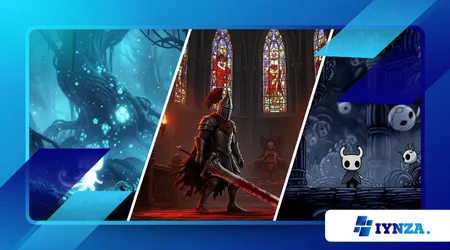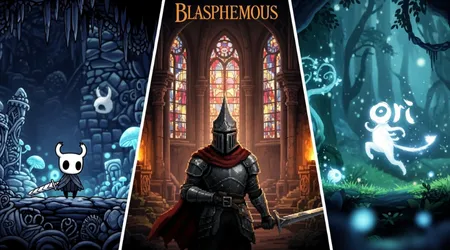The Rise of Metroidvania Games in the Indie Scene

The Rise of Metroidvania Games in the Indie Scene is not merely a nostalgia trend; it represents a perfect synergy between creative ambition and development constraints.
Anúncios
Named after the seminal Nintendo and Konami franchises, the genre’s structure a vast, interconnected map where progress is gated by acquiring new abilities has become the gold standard for small studios.
This design paradigm allows indie developers to craft experiences that feel enormous, profound, and deeply rewarding, rivalling the scope of AAA titles without their monumental budgets.
It is the ultimate illusion of scale, and 2025 is proving to be a landmark year for its continued evolution and commercial success.
The persistent appeal lies in the formula’s ability to foster genuine exploration and player agency, creating immersive experiences.
Players cherish the moments of discovery when a newly acquired double-jump or dash ability unlocks a previously unreachable corner of the map.
This rewarding loop keeps players engaged for dozens of hours, offering exceptional value for the price.
With an ever-growing digital marketplace, a well-executed Metroidvania stands out as a high-quality, long-lasting investment for gamers seeking depth.
Why Is the Metroidvania Structure Ideal for Indie Developers?
Independent studios frequently choose the Metroidvania framework because it cleverly addresses the limitations of small team sizes and limited resources. The genre converts constraints into compelling design features.
How Does the Genre Simulate an Open-World Experience in 2D?
A tightly designed Metroidvania world feels much larger than its actual asset count would suggest. The core design principle recycling the same environment by having players constantly revisit it with new skills is inherently efficient.
This “utility-gated exploration” transforms old paths into new challenges, reducing the need for sprawling, unique level designs demanded by open-world games.
A simple wall that blocked a path early in the game transforms into a satisfying moment of progression when the player returns with a newly found wall-climb ability.
This repetition with variation maximises the impact of every screen designed.
++ Top 10 NES Classics Every Gamer Should Know
What Advantages Do Ability-Based Gates Offer in Terms of Progression?
Ability gates provide a natural, intuitive progression curve that is easier to balance and implement than a complex RPG levelling system. New skills are tangible keys to new areas.
These unlocks serve as both combat enhancements and traversal tools, giving the player immediate, rewarding feedback.
This system ensures players constantly feel their character growing stronger and more capable, without the need for intricate narrative exposition to justify new powers.
It’s an organic integration of storytelling and mechanics that small teams can masterfully orchestrate.
Furthermore, the linear nature of ability acquisition, while the world is non-linear, allows developers to control the difficulty spikes precisely. They know exactly which tools the player possesses when they reach a new boss encounter.
Also read: How Indie Horror Games Are Redefining Fear
Where Does the Genre’s Artistic Flexibility Play a Role?
The 2D nature of most Metroidvania games allows for stunning, highly detailed art styles that are labour-intensive but manageable for smaller art teams.
Hand-drawn or pixel-art aesthetics lend themselves perfectly to the genre. This focus on distinct visual quality gives each indie title a unique identity in a crowded market.
Look at the gothic cosmic horror of Blasphemous or the whimsical, fluid animation of Ori and the Blind Forest; their art is inseparable from their appeal.
This visual distinctiveness is a crucial marketing tool for the Rise of Metroidvania Games in the Indie Scene.
The artistic constraints of 2D also prevent the massive, constant demand for new 3D assets and complex lighting that plagues larger productions, simplifying the development pipeline considerably.

What Statistical Evidence Supports the Commercial Viability?
The commercial success of high-profile titles has undeniably fueled the current excitement, creating a demonstrably profitable niche for independent studios. The market is responsive to quality.
How Have Recent Launches Validated the Metroidvania Market?
Recent data confirms that this genre is a financial powerhouse within the indie market, commanding both high sales volume and fervent community engagement. The release of a single, highly anticipated title can redefine market expectations.
For instance, the long-awaited release of Hollow Knight: Silksong in September 2025 quickly entered the top 20 games with the highest concurrent player count in Steam history, demonstrating a massive, pre-existing demand.
Such success stories show that the appetite for deep, challenging, 2D exploration is far from satiated.
This dedicated fanbase offers a relatively safe harbour for new developers, knowing a loyal audience exists ready to embrace their work. The genre fosters a unique, passionate word-of-mouth marketing cycle that is invaluable.
Read more: Best retro indie games for beginners
What Does Market Data Tell Us About Indie Game Revenue?
The independent gaming sector experienced a monumental shift in recent years, with data showing a significant increase in revenue share. This overall boom provides fertile ground for the Metroidvania subgenre.
According to a Sensor Tower analysis of the Global Indie Games Market in 2024 (as of September 30th), independent game revenue on Steam for the first time nearly matched the revenue of AA and AAA games, with the indie revenue share having doubled since 2018.
While this statistic encompasses all indie games, the success of “Triple-I” (Indie with high production value) games, many of which are Metroidvanias, significantly drove this growth, proving players are willing to pay for quality over brand name.
| Title Tier | Average Revenue (First Game in Portfolio) | Average Revenue (Third Game in Portfolio) |
| Indie Debut | $120,000 | N/A |
| Indie Established | N/A | $209,000 |
Source: Sensor Tower/Steam Data, 2024
Why Does the Community Value Metroidvania Longevity?
Gamers appreciate the perceived value proposition of Metroidvania games, which offer significant playtime for a typically modest indie price point. The intricate map design encourages high replayability.
The meticulous design of these worlds often includes numerous secrets, optional bosses, and multiple endings, encouraging dedicated fans to return long after the credits roll.
This longevity builds a strong reputation for the game, sustaining positive sales momentum through ongoing recommendations. This focus on depth, rather than pure quantity of content, distinguishes a great Metroidvania.
It’s an analogy for a complex mechanical watch: it doesn’t boast the size of a digital screen, but its intricate internal workings offer enduring satisfaction and precision.
What Key Design Innovations Define the Modern Metroidvania?
Today’s best Metroidvania titles are not just cloning the classics; they are actively innovating, blending in mechanics from other popular genres to forge new, compelling experiences.
This creative fusion ensures the Rise of Metroidvania Games in the Indie Scene continues unabated.
How Are Combat Systems Evolving Beyond Simple Platforming?
Modern Metroidvanias frequently incorporate elements from ‘Soulslike’ games, introducing deliberate, high-stakes combat focused on parrying and precise dodging. This significantly raises the skill ceiling.
Games like Nine Sols, with its parry-or-perish combat, demonstrate how tight, responsive controls and demanding enemy patterns elevate the genre from a simple action-platformer to a true challenge.
This added combat depth attracts a player segment that values precision and difficulty.
Imagine an area locked by an elemental barrier; the ability to cross it is granted by defeating a difficult, Soulslike-inspired boss who yields the Aura Dash skill, which is then used in traversal and combat. This seamless ability integration is the genre’s genius.
Why is Environmental Storytelling So Important Now?
The narrative heavy-lifting in a modern Metroidvania often happens through the environment itself, rather than lengthy cutscenes or dialogue boxes. This method respects the player’s time and desire for seamless immersion.
The world’s design, object descriptions, and placement of ruins subtly weave a story of a lost kingdom or a failed experiment, forcing the player to be an active archaeologist.
This technique makes the act of exploration itself the primary storytelling device, deeply rewarding the player’s curiosity.
This approach is highly effective for small teams, as it relies on art direction and flavour text rather than complex motion capture or voice acting. It delivers a rich, interpreted narrative with minimal resources.
Conclusion: The Endurance of the Gated World
The Rise of Metroidvania Games in the Indie Scene is a powerful testament to the enduring appeal of clever, economical design.
By offering players the satisfying cycle of exploration, discovery, and mastery within a vast, interconnected 2D realm, indie developers have found their sweet spot.
These games provide a deep, challenging, and artistically distinct alternative to the homogeneity of many AAA titles. The genre’s commercial viability is proven, and its structural flexibility makes it a fertile ground for innovation.
The future of this subgenre looks brighter than ever, with new titles constantly pushing the boundaries of what a 2D exploration game can achieve.
If you haven’t yet delved into the current wave of these fantastic indie titles, are you truly experiencing the best of modern gaming?
Share your experience in the comments: Which non-combat ability do you think is the most satisfying to unlock in a Metroidvania (e.g., Double Jump, Wall Climb, Dash), and why?
Frequently Asked Questions (FAQ)
What defines a game as a Metroidvania?
A Metroidvania is defined by a non-linear, interconnected world map where progress is gated by the acquisition of new character abilities or items.
The player constantly backtracks to previously inaccessible areas, using new powers to unlock further paths.
Why do so many indie games use the pixel-art style?
Independent developers frequently use pixel art because it allows small teams to create a highly detailed, aesthetically unique, and artistically controlled visual experience with fewer resources than required for high-fidelity 3D graphics. It also taps into a strong sense of nostalgia.
What is a “Triple-I” (Triple-I) game in the context of Metroidvanias?
“Triple-I” refers to independent games that boast the high production values, polish, and development scope often associated with AAA games, but are funded and developed outside the traditional publisher-driven system.
Highly successful Metroidvanias like Hollow Knight often fall into this category.
Is the term Metroidvania used officially by game developers?
While not an official genre classification by every major publisher, the term is universally accepted and widely used by developers, critics, and the gaming community to describe this specific subgenre of action-adventure platformers.
